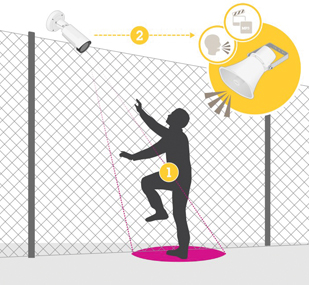Network audio is a growing area, with the developments in technology opening an array of new possibilities for integrating audio into network systems, writes David Needham at Axis Communications.
Audio is a natural companion to security surveillance cameras. As Axis is well known in the camera space, attendees at ISE were surprised to only see audio solutions at the stand. However, once you look at the core purpose of surveillance cameras – seeing what is going on in an environment, the correlation with network audio is extremely logical. Rather than passively watching what’s happening, the addition of audio allows users to hear and speak to those on camera, improving the security solution’s effectiveness.
Adding network audio to a video surveillance solution can help to prevent criminal actions and the need to call security guards or even the police. For example, a speaker connected to an alarm system can be automatically triggered to play an audio message or enable operators to remotely address a potential intruder. Once an alert has been triggered by the camera, an automatic, pre-recorded message can be immediately played, while an operator can review the scene and communicate via a live message, such as warning the intruder “in the red jacket” to leave the premises. Hearing a spoken message is much more effective at deterring criminals than just the sound of a traditional siren.
Public address and logical zone management
An interesting problem a lot of public institutions, such as schools and universities visiting ISE have is audio zone management. In an ideal world, they would like every individual classroom to be its own zone, but with legacy technology this is quite difficult – the number of connections and technical components needed to create separate zones on that scale, requires a dedicated technical room, complicated design and set up, which is very expensive with analogue systems.
However, the latest developments in network audio means each speaker has its own IP address and can be individually addressed on the network. By using Power over Ethernet (PoE) technology, one standard network cable is all that is needed to both connect and power each speaker to the existing standard network infrastructure. This means one speaker can be selected either in isolation or added to / removed from multiple groups as needed, via one central dashboard using a drag-and-drop interface. This makes it possible to play and schedule audio content, such as live announcements or scheduled reminders like bells, to specific speakers – something that comes in quite handy when the announcements of the principal are, for example, only relevant for pupils in certain classes. As well as helping to create more targeted broadcasts, the use of network audio streamlines the maintenance and management of the audio systems. All audio devices can be managed centrally on the network, to run health checks and identify any issues, as well as more everyday tasks such as volume control. Something that is especially important in the education sector where budgets can be stretched, this system offers a flexible solution that can be scaled and adjusted to meet changing needs.
Sound quality from London to Paris
Another area of audio that a lot of people are interested in is the quality of the sound produced by network speakers, especially in the hospitality and retail sector where customer experience is a priority. Interestingly, many solutions at ISE focused on high quality speakers that produce quality sound through the speakers’ components. In this case, the audio has been received from the rack, where the sound is produced, then delivered via a wire to an analog speaker (albeit a high quality speaker).
However, a new way of delivering high quality audio – especially over long distance – is by sending the audio signal digitally all the way to the speaker via the network. Each speaker contains a digital signal processor, which tunes the signal using advanced equalisation, filtering and compression. This clarifies voice and optimizes music to ensure the highest quality sound. By not relying on traditional cables, the audio data can be far away, yet not lose any quality through delivery to the speaker’s location. This is ideal in retail environments, for example where stores may be scattered all over the country – or multiple countries – yet should all be playing the same music. It means head office can centrally control all background music, safe in the knowledge they are not compromising on the quality of the audio – and therefore customer experience – across all their stores.
What makes true network audio?
Inevitably, another key focus of audio solutions was form factor – different aesthetics and features that make speakers more desirable for specific audiences and their uses. However, a lot of these solutions claim to offer network audio capabilities, yet the speakers are essentially dumb terminals that play digital audio that is processed in the rack. A new solution is needed to bring true network audio – intelligent audio – to these speakers. Therefore, to increase the intelligent audio options for end users, without them having to compromise on the design of new investments, or scrapping legacy speakers, Axis revealed its new device: AXIS C8210 Audio Amplifier. It is a box containing the intelligence of IP network audio, which can be added to existing passive speakers to bring the true capabilities of network audio to a customer’s preferred speaker design.
Learn more: https://www.axis-communications.com/network-audio-axis.









